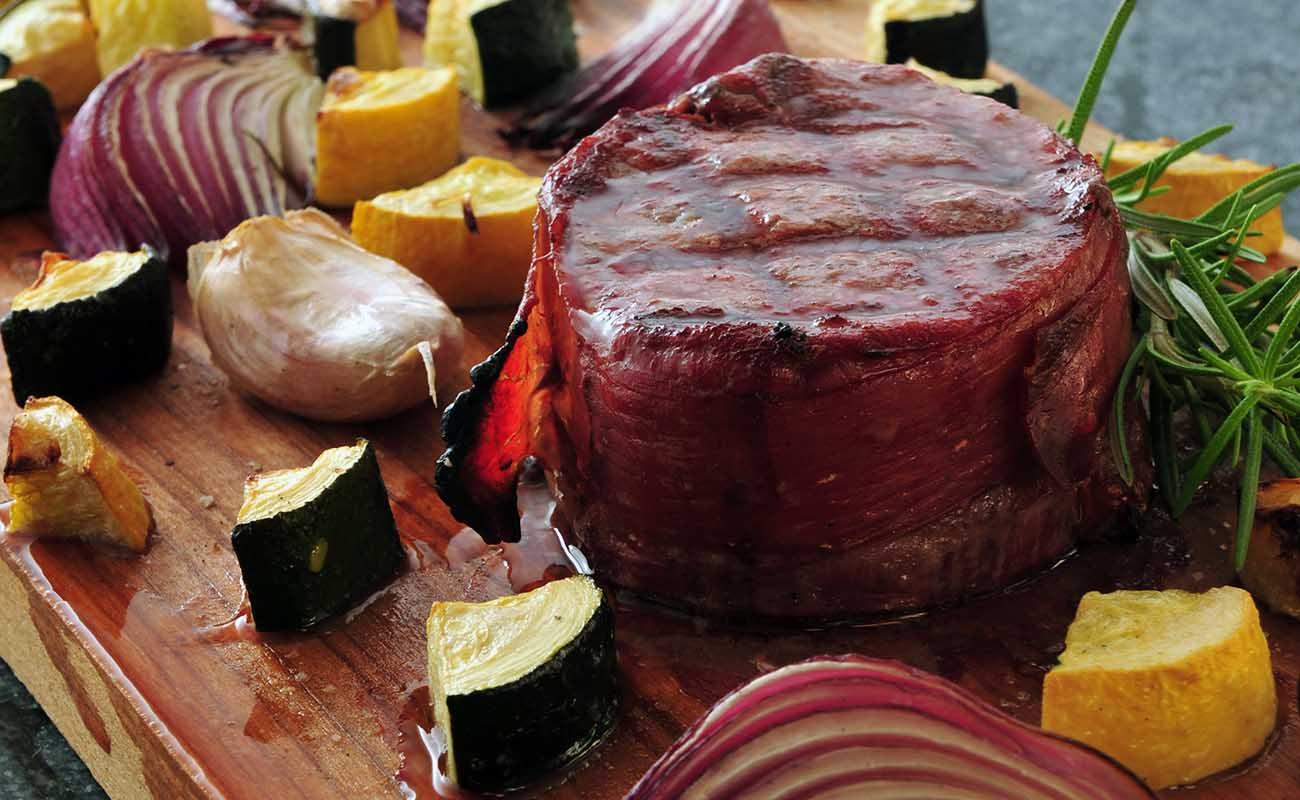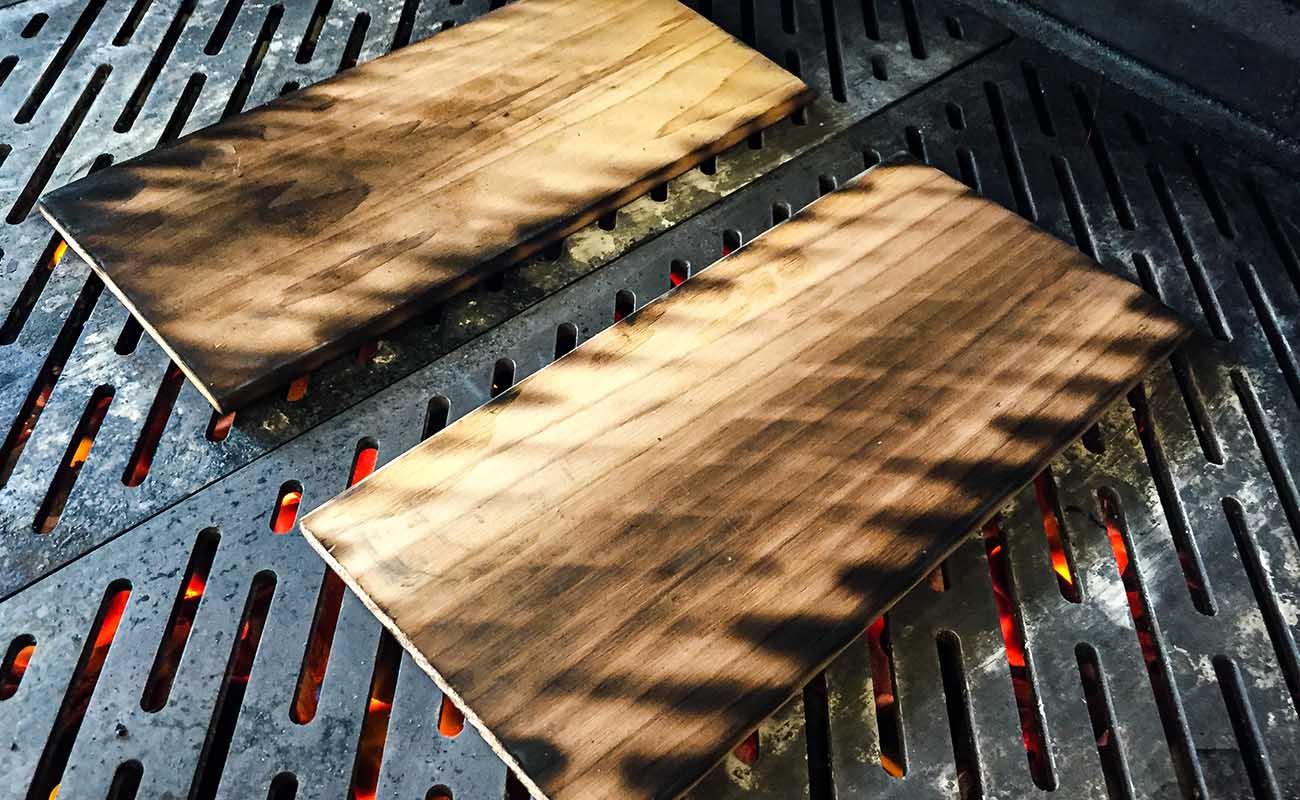
Cooking meats on a wooden board is an old tradition. Some believe it originated with the Native American tribes of the Pacific Northwest. Others believe the practice originated in Scandinavia. For the backyard chef, it matters little who was the first to cook meat on a plank. The important thing is to enjoy the unique process, the impressive presentation and the wood-infused flavor. Plank cooking is easy, it can be used for meats, fish and vegetables, and it can be a nice change of pace.
The recipe above combines tenderloin filet steaks with mixed vegetables on an alder plank.

Crab-Crusted Bone-in Filets on Cedar Planks
THE BASICS OF PLANK COOKING
You can enjoy plank cooking in the Hybrid Fire Grill, the Shokunin Kamado Grill, and in the Artisan Fire Pizza Oven. The most important key to successful plank cooking is to keep the temperature of the wood plank below 450°F so that it is less likely to catch fire.
- In the grill, do your cooking in the indirect zone. The planks should be next to the fire; not over the fire.
- In the pizza oven, place a wire cooling rack between the plank and the baking stone to create an air gap. Keep the rear flame on medium or low, and rotate the plank frequently.
- For quick cooks of smaller cuts, you can achieve the best results with dry planks.
- For longer cooks of larger cuts, soak the planks in water, beer, tea or white wine to help keep the planks from catching fire. Thick planks need to be soaked for as many as four hours.
- Keep a squirt bottle of water handy to douse any fires that may occur before they can ruin your meal. (If you’re cooking in the pizza oven, pull the plank out of the oven before squirting with water.)
- To increase the wood-fired flavor of your plank cooking, briefly toast the tops of the planks before adding the food.
Cedar is the most popular wood species for plank grilling, but we encourage you to try other varieties, especially hardwoods like alder, oak, hickory and maple. Each will infuse your food with its own, distinct p
WHERE TO GET PLANKS FOR COOKING
A great place to purchase planks is at a hardwood store that serves carpenters. As long as the wood is clean, untreated and one of the species mentioned above, it should be safe to cook on. We like to use thick planks because they are less likely to catch fire while cooking, and they are reusable for at least a couple of cooking sessions. Thick planks are also less likely to warp. Purchasing your planks at a hardwood store has two main benefits: they cost less than pre-processed and packaged grilling planks; and you can choose any size and thickness you desire. Most stores will gladly cut a long board into smaller pieces for you. A typical charge for this service is $0.25 per cut.

Cedar-Planked Salmon with Broccolini
PLANK GRILLING IN THE HYBRID
Plank grilling in the Hybrid Fire Grill using the gas burners can be very straightforward.
- Preheat the grill with all of the Dragon Burners on HIGH.
- Turn off at least one burner to create the indirect zone for plank grilling.
- Toast one side of the plank on the hottest part of the grill for a couple of minutes, then flip it over onto the indirect zone.
- Add the food on top of the plank, close the lid, and cook until done.
Additional tip: If using soaked planks, you might want to quickly sear the food on the grill grates before transferring to the planks. This technique is used in our Alder-Planked Filet Mixed Grill recipe.

Oak-Planked Broccoli with Shallots, Lemon and Ginger Soy Glaze
PLANK GRILLING IN THE SHOKUNIN
The Shokunin Kamado Grill is the perfect tool for roasting food on a plank. The offset charcoal fire provides even heat, and the interior curve of the lid browns the food from above. Because the temperature in the Shokunin is so steady, we typically do not soak the plank.
- Start a moderate charcoal fire with the fire grate on the “roasting level” and a charcoal fence confining the charcoal to one side or the other.
- Preheat the grill to 400°F, dialing in the control vents to maintain that temperature.
- Place the plank on the cooking grate above the fire and close the lid for two minutes.
- Remove the plank from the grill and arrange the food on the plank, placing the food on the side that was toasted against the grill.
- Position the plank with the food in the indirect zone (away from the fire) and roast to the desired doneness.
PLANK ROASTING IN ARTISAN FIRE PIZZA OVEN
The intense, radiant heat from the top and rear of the pizza oven is ideal for plank roasting. The plank will begin to smoke quickly to infuse the food with flavor, and perfect browning can be achieved. We typically plank quicker-cooking foods in the pizza oven, and we do not soak the planks. Attention and diligence are required to keep the planks from catching fire by rotating the planks frequently. Use tongs and gloves when moving the planks.
- Preheat the pizza oven with the upper and lower burners both on HIGH. for about 20 minutes.
- Set the lower burner control to LOW, and the upper burner to Medium.
- Place a wire cooling rack on the cooking deck, and the plank with food on top of the rack.
- Keep an eye on the plank as well as the food, and rotate to prevent the plank from overheating at the rear. Sometimes it is easier to rotate the wire rack together with the plank.

Maple-Planked Lake Trout with Chile Morel Barbecue Rub
WHAT TO COOK ON PLANKS
If it is good roasted, it is probably great on a plank. We’ve enjoyed mushrooms and green vegetables as well as corn and cracked potatoes. Fish is fantastic, particularly walleye, trout and salmon. Red meat works well too. A rolled pinwheel steak with cheese and peppers or spinach can be eye-catching as well as delicious. Crusted steaks and cheeseburgers are also fun.
Here are some plank-grilled recipes from our own Kalamazoo Grillmaster:
- Cedar-Planked Brie
- Hickory-Planked Barbecue Corn
- Double-Oaked Cowboy Steaks
- Plank-smashed Potatoes with Shishito Peppers
- Cedar-Planked Barbecue Shrimp
- Maple-Planked Salmon with Maple Soy Glaze
- Alder-Planked Whole Mackerel
- Cedar-Planked Bone-In Filets with Horseradish Crab Butter
- Alder-Planked Filet Mixed Grill
ADDITIONAL TIPS
- If you’re using a charcoal fire, try mixing wood chunks of the same species as your hardwood plank into your lump charcoal to amplify the flavor. Do not put cedar chunks in the charcoal — only hardwood.
- Try placing fresh herbs between the plank and your meat or fish.
- Cook your vegetables on the same plank as the protein, and serve directly on the plank. If the vegetables will cook more quickly than the protein, start the protein first and add the vegetables later.
- Rotate and reposition your planks as often as you need for even cooking. For some foods, like steak, you may want to flip the food on the plank halfway through cooking.
- Keep a spray bottle handy filled with clean water. Use this to douse the flames if your planks do catch on fire.
- After use, a plank can be cleaned and used again. Rinse well with water, and then put the plank back into a hot grill for at least 10 minutes to kill any bacteria. It is recommended that a plank used to grill fish should only be reused to cook more fish.

Toast the planks directly over the fire for a couple of minutes, then flip them over and place the food on the toasted side.


